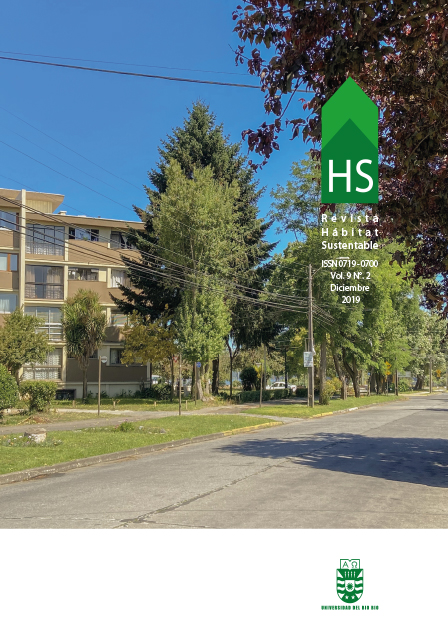Oasis urbano: Una propuesta de acondicionamiento térmico para el metro de Santiago
DOI:
https://doi.org/10.22320/07190700.2019.09.02.02Palabras clave:
Climatización, estaciones de subterráneo, espacio públicoResumen
Las estaciones subterráneas del Metro de Santiago pueden llegar a experimentar temperaturas de alrededor de 32ºC en la zona de andenes durante la época estival, afectando directamente a los usuarios del transporte público. Situaciones similares se repiten en otros sistemas ferroviarios subterráneos del mundo y las soluciones implementadas no han logrado resolver el problema por completo, lo que se traduce incluso en altos costos de operación y mantención. Este trabajo expone una propuesta de acondicionamiento térmico pasivo que toma como caso de estudio la estación Tobalaba L1 del Metro de Santiago. Aprovechando los pozos de ventilación existentes, se simuló un sistema de enfriamiento evaporativo que busca reducir la temperatura al interior de la zona de andenes y, al mismo tiempo, contribuir a reactivar el espacio público en la superficie. La solución propuesta permitió una disminución de la temperatura promedio de 2,5ºC en verano y 3,6ºC en invierno, evidenciando que es posible llegar a igualar los alcances de algunas soluciones activas, pero con menores costos involucrados gracias al nulo gasto energético y al aprovechamiento de las preexistencias; y con mejoras en las condiciones del espacio público dada la incorporación del factor cualitativo aportado por la arquitectura.
Descargas
Citas
AENOR (2008). Parámetros del ambiente interior a considerar para el diseño y la evaluación de la eficiencia energética de edificios incluyendo la calidad del aire interior, condiciones térmicas, iluminación y ruido. UNE-EN 15251:2008. Madrid:AENOR.
AMERICAN SOCIETY OF HEATING, REFRIGERATING AND AIRCONDITIONING ENGINEERS, INC. (2017). AHSRAE Handbook Fundamentals. Atlanta: ASHRAE.
Arballo, B., Kuchen, E., Alamino-Naranjo, Y. y Alonso-Frank, A. (2016). Evaluación de Modelos de Confort Térmico para Interiores. En: VIII Congreso Regional de Tecnología de la Arquitectura – CRETA, Universidad Nacional de San Juan, Islas Malvinas.
Arden, C. (2013). London underground tunnels to heat homes. Islington now. Recuperado de http://islingtonnow.co.uk/londonunderground-tunnels-to-heat-homes/.
Con 106 ventiladores gigantes en 8 estaciones Metro capeará el calor (2018). La Hora. Recuperado de http://www.lahora.cl/2018/11/106-ventiladores-gigantes-8-estaciones-metrocapeara-calor/.
Fanger, P. O. (1973). Thermal Comfort. New York: McGraw-Hill Book Company.
Guzmán, J. M. (2017). La Gestión Municipal de áreas verdes en el gran Santiago. Santiago: Fundación Mi Parque.
Hendriks, M., Cubillo, J. M. y Cuesta, M. (2011). Refrigeración del Metro con Geotermia. Retos y experiencias de un caso real: Metro Madrid - Estación Pacífico. El Instalador, (482), 118-126.
Herrera, J. (2018). Tobalaba, Manquehue y La Cisterna son las estaciones de metro con mayor afluencia. El Mercurio recuperado de https://gobierno.udd.cl/cpp/noticias/2018/07/03/tobalabamanquehue-y-la-cisterna-son-las-estaciones-de-metro-con-mayorafluencia-el-mercurio/.
Herrero, R. (2009). Sistemas de Ventilación en Ferrocarriles Metropolitanos: Panorámica y Estrategias de Diseño. Proyecto fin de Carrera - Ingeniería Industrial. Universidad Carlos III de Madrid, Madrid, España.
Hoyt, T., Schiavon, S., Piccioli, A., Cheung, T., Moon, D. y Steinfeld, K. (2017). CBE Thermal Comfort Tool. Center for the Built Environment. Recuperado de http://comfort.cbe.berkeley.edu/EN.
Instalan megaventiladores para disminuir el calor en estaciones de Metro (2010). La Tercera. Recuperado de https://www.latercera.com/noticia/instalan-megaventiladores-para-disminuir-el-calor-enestaciones-de-metro/.
Instituto Nacional de Estadísticas (INE) (2019). Índices de Remuneraciones y Costo de Mano de Obra - IR ICMO. Instituto Nacional de Estadísticas Chile. Recuperado de https://www.ine.cl/estadisticas/laborales/ir-icmo.
Liencura, J. (2019). ¡Estamos fritos! Hasta 38º deben soportar pasajeros del transporte público en Santiago. Publimetro Chile. Recuperado de https://www.publimetro.cl/cl/noticias/2019/01/04/hasta-38oc-soportar-pasajeros-transantiago-metro.html.
Metro S.A. (2007). Anexos Estadísticos 2007. Santiago.
Metro S.A. (2010). Metro implementa mega ventiladores para disminuir calor en estaciones. Web Metro de Santiago. Recuperado de https://www.metro.cl/noticias/detalle/923.
Metro S.A. (2013). Metro inicia plan de verano 2013-2014. Web Metro de Santiago. Recuperado de https://www.metro.cl/noticias/detalle/1339.
Metro S.A. (2015). Especificaciones técnicas. Servicio de mantenimiento de sistemas de ventilación industrial y nebulizadores en estaciones de Metro S.A. Santiago.
ONDAC. Manual de Costos: Materiales y Actividades para la Construcción. Santiago: ONDAC, 2018.
The Norwegian Metereological Institute (2016). WeatherSpark. Recuperado de https://weatherspark.com/#!dashboard;loc=-33.4184,-70.6020.
Descargas
Publicado
Cómo citar
Número
Sección
Licencia
El contenido de los artículos que se publican en cada número de Hábitat Sustentable, es responsabilidad exclusiva de los autores y no representan necesariamente el pensamiento ni comprometen la opinión de la Universidad del Bío-Bío.
Los autores/as conservarán sus derechos de autor y garantizarán a la revista el derecho de primera publicación de su obra, el cuál estará simultáneamente sujeto a la Licencia de Reconocimiento de Creative Commons CC BY-SA que permite a otros compartir-copiar, transformar o crear nuevo material a partir de esta obra con fines no comerciales, siempre y cuando se reconozcan la autoría y la primera publicación en esta revista, y sus nuevas creaciones estén bajo una licencia con los mismos términos.











 Programa de Información Científica/Concurso Fondos de Publicación de Revistas Científicas 2018/ Proyecto Mejoramiento de Visibilidad de Revistas UBB (Código:FP180007)
Programa de Información Científica/Concurso Fondos de Publicación de Revistas Científicas 2018/ Proyecto Mejoramiento de Visibilidad de Revistas UBB (Código:FP180007) 





